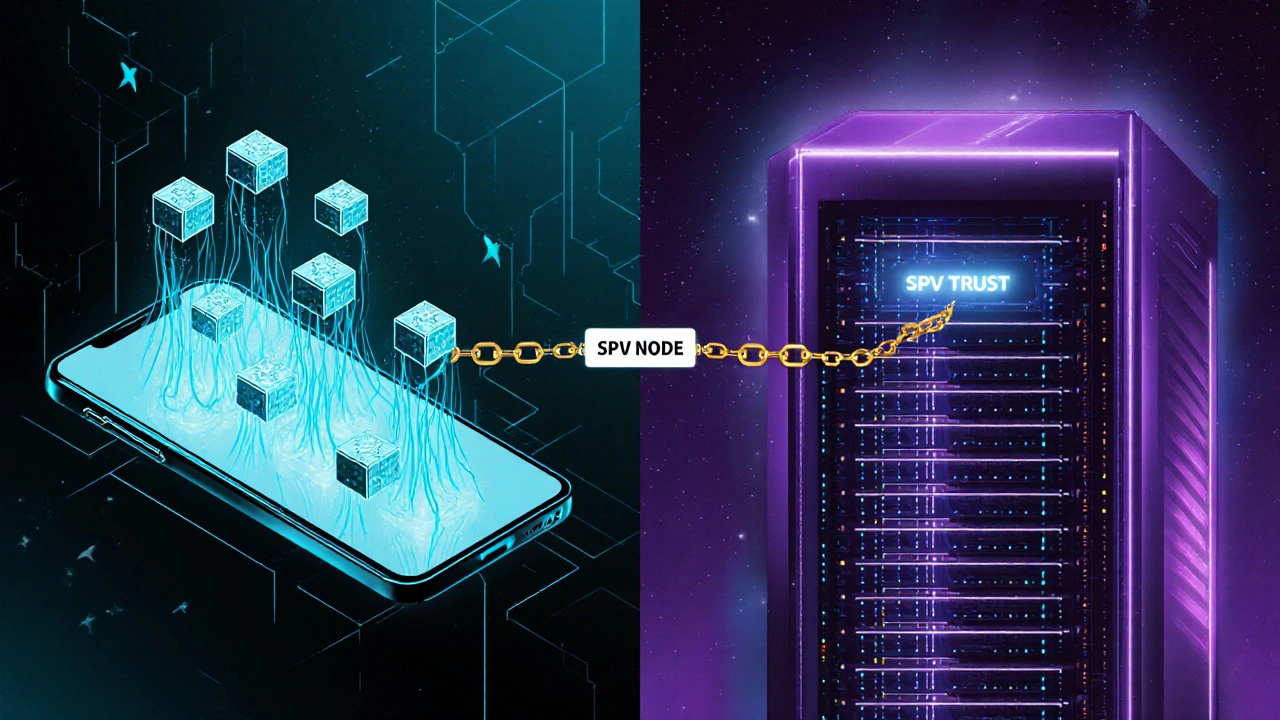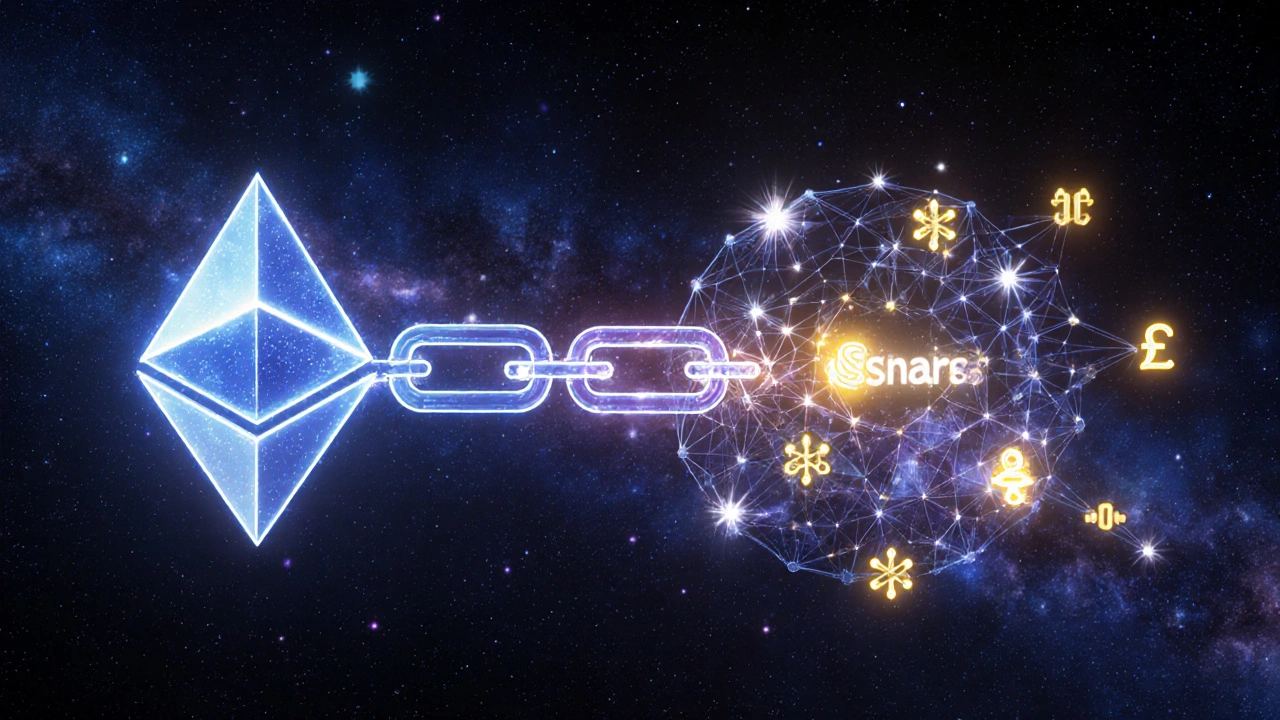Imagine checking your Bitcoin balance on your phone in under 10 seconds-no waiting hours for a sync, no占用 500GB of storage. That’s the power of light clients and SPV. They let you verify transactions without running a full node. And for most people, that’s all you need.
What Exactly Is SPV?
SPV stands for Simplified Payment Verification. It’s not magic. It’s math. Back in 2009, Satoshi Nakamoto wrote in the Bitcoin whitepaper that not everyone needs to download the whole blockchain to trust it. He figured out a way to prove a transaction is real using just the block headers-tiny 80-byte chunks of data that contain the cryptographic fingerprint of every transaction in a block. Instead of downloading every transaction ever made (which, as of 2023, is over 450GB for Bitcoin), an SPV client only grabs the headers. That’s less than 0.1GB. You’re not seeing the full picture-you’re just checking the signature on the envelope to make sure it wasn’t tampered with. Here’s how it works: when you receive a payment, your wallet asks a few random peers for proof that your transaction is inside a specific block. The peer sends back a Merkle proof-a short list of hashes that, when combined, lead back to the Merkle root stored in the block header. If the math adds up, your transaction is confirmed. You don’t need to know the other 1,999 transactions in that block. You just need to know yours is there.Why Do Light Clients Matter?
Full nodes are powerful. They validate every rule of the network: double-spends, script conditions, block size limits. But they’re heavy. You need a powerful computer, lots of storage, and constant bandwidth. Most people don’t have that. Light clients change that. They turn your smartphone into a blockchain validator. Apps like Electrum and BlueWallet rely on SPV. Together, they’ve been downloaded over 25 million times. Why? Because they’re fast. They use less battery. They work on old phones. You can set one up while waiting for coffee. In 2023, 82% of mobile crypto users were using light clients. That’s not a coincidence. It’s necessity. If blockchain is supposed to be decentralized, it can’t only be used by people with home servers and gigabit internet.How Secure Are They?
This is the big question. Are light clients safe? The short answer: yes-for everyday use. No, if you’re moving $100,000. SPV assumes the majority of the network is honest. As long as most miners (in Bitcoin) or validators (in Ethereum) are following the rules, the longest chain is the real one. Your wallet checks that the block headers have enough proof-of-work (or proof-of-stake finality) and trusts that the chain hasn’t been rewritten. But here’s the catch: if someone controls over 51% of the network’s hash power, they can create a fake chain and trick your light client into accepting a fraudulent transaction. That’s a 51% attack. It’s rare. It’s expensive. But it’s possible. That’s why experts recommend waiting for six confirmations before accepting large payments via SPV. Six blocks means it’s computationally impractical for an attacker to reverse the transaction. Also, light clients can’t verify smart contracts. If you’re interacting with DeFi protocols on Ethereum, your wallet doesn’t check if the code executed correctly. It only checks that your transaction was included. That’s fine for sending ETH. It’s risky for lending or staking.SPV vs Full Nodes: The Real Difference
Let’s compare them side by side.| Feature | Light Client (SPV) | Full Node |
|---|---|---|
| Data Stored | ~50MB (block headers only) | 450GB+ (Bitcoin), 4TB+ (Ethereum) |
| Verification Depth | Checks transaction inclusion only | Validates every rule, every transaction |
| Security Model | Trusts majority of network | No trust required |
| Device Requirements | Works on $100 phones, 1GB RAM | Desktop or server, SSD storage |
| Sync Time | Under 1 minute | Days to weeks |
| Use Case | Mobile payments, casual users | Merchants, exchanges, developers |
Full nodes are the gold standard. They’re the reason Bitcoin is still secure after 15 years. But you don’t need to run one to use Bitcoin. Just like you don’t need to build your own internet router to browse the web.

How Light Clients Evolved Beyond Bitcoin
Bitcoin’s SPV was simple. It relied on proof-of-work. But Ethereum switched to proof-of-stake in 2022. That changed everything. In PoS, there’s no mining. Instead, validators vote on blocks. And once a block gets enough votes, it’s “finalized.” Light clients on Ethereum now don’t just check chain length-they check for these finality signals. They look for two justified checkpoints and one finalized block. That’s how they know the chain won’t roll back. Even more advanced are cross-chain protocols like Cosmos IBC. These use light clients to verify entire blockchains from other networks. Imagine a wallet on Solana that can prove a transaction happened on Ethereum-without connecting to Ethereum’s full nodes. That’s light clients doing heavy lifting. And then there’s the future: stateless light clients. Researchers at Stanford and the Ethereum Foundation are building clients that can verify not just that a transaction happened, but that the code behind it executed correctly. Using cryptographic proofs like zk-SNARKs, these new clients may soon offer near-full-node security with SPV-level efficiency.What Can Go Wrong?
SPV isn’t foolproof. And users have been burned. In March 2022, Breadwallet had a bug. It didn’t properly handle chain reorganizations. For 12 hours, 200,000 users saw wrong balances. Some thought they lost money. They hadn’t. The wallet just got confused. Another issue: malicious peers. If your wallet connects only to one dishonest node, it can feed you fake headers. That’s why good wallets connect to multiple peers and cross-check. But not all do. A 2022 audit found only 61% of mobile wallets handled chain reorgs correctly. Also, privacy. Early SPV wallets used Bloom filters to ask for transactions. But that leaked your address patterns. Modern wallets now use Compact Block Filters (BIP 157/158), which are much better. Still, if you’re using an old wallet, you might be exposing more than you think.Who Should Use Light Clients?
If you’re:- Buying coffee with Bitcoin on your phone
- Sending ETH to a friend
- Checking your portfolio on the go
- Using a wallet with 10 million+ downloads
Then SPV is perfect. It’s fast, reliable, and secure enough for daily use.
If you’re:
- Running a merchant service accepting $10,000+ payments
- Staking or interacting with DeFi contracts
- Building a blockchain app
- Concerned about 51% attacks
Then you need a full node-or at least a trusted third-party node provider.

The Future of Light Clients
By 2026, Vitalik Buterin predicts most Ethereum users will be running light clients with full-node security. That’s not a fantasy. It’s the direction of research. Validity proofs, data availability sampling, and fraud proofs are closing the gap. Regulators are taking notice too. The EU’s MiCA law, effective in December 2024, will require wallet providers to use “adequate verification mechanisms.” That could mean stricter standards for SPV implementations-better peer selection, mandatory confirmation thresholds, audit trails. The market is already shifting. Cross-chain bridges using light clients grew from $15B to $32B in TVL between 2022 and 2023. Mobile crypto usage hit 67% of all interactions. Light clients aren’t a workaround. They’re the default.Final Thoughts
You don’t need to run a full node to trust Bitcoin or Ethereum. Light clients make that possible. They’re not perfect. But they’re good enough-for most people, most of the time. The goal of blockchain isn’t to make everyone a node operator. It’s to make trust accessible. SPV does that. It brings decentralization to your pocket. Use a light client. Just know its limits. Wait for six confirmations. Don’t use it for large DeFi trades. And if you ever feel unsure-run a full node once, just to see how it works. You’ll understand why it matters.Are light clients safe for everyday crypto use?
Yes, for most daily transactions like sending or receiving small amounts of Bitcoin or Ethereum. Light clients verify transaction inclusion using block headers and Merkle proofs, which are cryptographically secure. However, they rely on the assumption that the majority of the network is honest. For transactions over $10,000, it’s safer to wait for six confirmations or use a full node.
Do light clients need internet to work?
Yes. Light clients connect to peer nodes to request block headers and Merkle proofs. Without an internet connection, they can’t verify new transactions. However, they can still show your balance and transaction history based on the last synced data. Offline storage of private keys is still secure-just not real-time verification.
Can light clients be hacked?
Not directly. The cryptography behind SPV is sound. But the implementation can be flawed. If a wallet connects only to malicious peers, it can be fed fake headers. Poorly coded wallets may also mishandle chain reorganizations, leading to incorrect balance displays. That’s why it’s critical to use well-established wallets like Electrum or BlueWallet, which have been audited and updated regularly.
Why can’t light clients verify smart contracts?
Light clients only check if a transaction is included in a block. They don’t execute the code inside it. So if you send ETH to a DeFi contract, your wallet confirms the transaction went through-but doesn’t verify if the contract actually locked your funds, paid interest, or executed correctly. Only a full node can do that. That’s why interacting with DeFi via SPV wallets carries hidden risk.
Is SPV still used on Ethereum after the merge?
Yes, but it’s different. After Ethereum switched to proof-of-stake in 2022, traditional SPV (which relied on proof-of-work chain length) was replaced with a new light client protocol. Now, Ethereum light clients verify “finalized checkpoints” signed by validator committees. This ensures economic finality, meaning blocks can’t be reversed without massive economic penalties. The security model changed, but the goal-lightweight verification-remains the same.
Do I need a light client if I use a centralized exchange?
No. If you keep your crypto on Binance, Coinbase, or Kraken, those platforms handle all blockchain verification for you. You’re trusting them, not the blockchain. Light clients are for people who want to control their own keys and verify transactions themselves-without running a full node. If you’re not holding your own private keys, you don’t need a light client.
What to Do Next
If you’re new to crypto and want to try a light client:- Download a trusted wallet like Electrum (for Bitcoin) or MetaMask (for Ethereum).
- Set it up. It should sync in under a minute.
- Send a small test transaction.
- Wait for three confirmations. Then six.
- Check your balance. It should match what you sent.
If you’re curious about full nodes, try running Bitcoin Core on an old laptop. It’ll take days to sync-but you’ll see exactly how the network works under the hood. You don’t have to keep it running. Just run it once. It’ll change how you think about trust.
Light clients aren’t the end of decentralization. They’re the bridge to it-for billions of people with smartphones, not servers.


Mark Brantner
November 20, 2025 AT 23:23so like... u just download 50mb and boom ur good to go? no joke i thought i needed a damn server lmao. this is wild. my phone runs this faster than my wifi loads cat videos
Kate Tran
November 21, 2025 AT 03:57i use bluewallet daily and never thought about how it works tbh. just glad i dont have to wait 3 hours for sync. also i once thought 'light client' meant it was lite beer version of bitcoin. turns out its just... smarter. cool
amber hopman
November 21, 2025 AT 10:08really appreciate how this breaks down the tradeoffs without fearmongering. i used to think light clients were sketchy until i read the merkle proof part. its like verifying a signature on a letter instead of reading every word the sender ever wrote. smart. also the 6 confirmations tip? lifesaver. just sent 0.02 btc to my buddy and waited. felt like a pro
Jim Sonntag
November 23, 2025 AT 03:18full nodes are the knights in shining armor but most of us are just trying to buy coffee not defend the kingdom. also why is everyone still using bloom filters in 2024? jfc
Deepak Sungra
November 23, 2025 AT 07:29bro this whole thing is just a glorified cheat code. you trust strangers on the internet to tell you your balance? and you call this decentralization? i mean sure it works... until it doesnt. remember when breadwallet glitched? 200k people panicked. i was one of em. woke up thinking i lost my life savings. turned out it was just a bug. still traumatized. also why does everyone act like this is normal? it’s not. its terrifying
Samar Omar
November 23, 2025 AT 12:29the sheer elegance of SPV is lost on the masses who think blockchain is just about ‘making money.’ what we’re witnessing here is the quiet revolution of cryptographic epistemology - the delegation of trust through mathematical consensus rather than institutional authority. the fact that a $100 phone can verify global financial history via 80-byte headers is not merely technical - it’s ontological. and yet, most users treat it like a vending machine. they don’t see the cathedral. they only see the change. sad. truly sad.
chioma okwara
November 24, 2025 AT 14:04you guys keep saying 'light client' but its 'lightweight client' not 'light client' like its a diet version. grammar matters. also 'merkle proof' not 'merkel' stop misspelling it. and dont say 'bitcoin core' like its a brand. its a software. ugh. and yes i use electrum. and yes i know what i'm talking about
John Fox
November 24, 2025 AT 23:44spv works fine for me. i dont care how it works as long as it does. just send me my btc and stop talking
Tasha Hernandez
November 25, 2025 AT 14:34okay but imagine if your entire financial life depended on someone else's phone being online. what if the peer you're connected to is a bot? what if the wallet devs are lazy? what if the 6 confirmations take 12 hours because the network is congested? and don't even get me started on the fact that your private keys are stored on a device that runs ads and tracks your location. we're not safe. we're just distracted. and now we're calling this 'decentralization'? it's a haunted house with glitter on the walls. beautiful. terrifying. and i'm still using it. because what else is there?